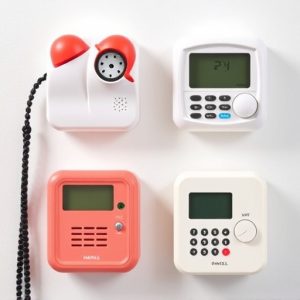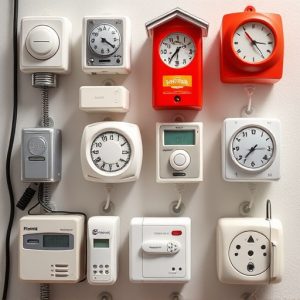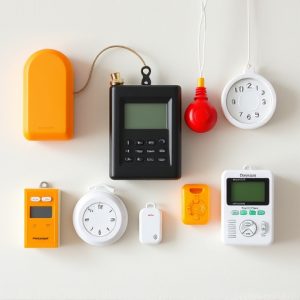Personal Alarms: Protecting You in Any Building with Distress Signals
Mobile safety alarms with distress signals provide versatile personal protection, deterring threats…….
Mobile safety alarms with distress signals provide versatile personal protection, deterring threats both indoors and outdoors. Key features include high-decibel sounds for attention-grabbing, compact size for convenient carrying, and GPS tracking for real-time location sharing. In buildings, the Personal Alarm Range in Buildings integrates into safety devices to emit distinct sounds that penetrate obstacles, alerting nearby individuals and emergency services promptly. Advanced technologies like voice communication and automatic fall detection further enhance security, offering peace of mind and life-saving capabilities in diverse settings from homes to public spaces. Effective implementation and clear activation protocols ensure swift response during emergencies, especially in large buildings.
“Staying safe on the go has never been more vital. Mobile safety alarms with distress signals offer a powerful personal protection tool, especially in unpredictable situations. This comprehensive guide explores how these advanced systems work and their benefits for individuals’ well-being. From understanding the technology behind them to implementing personal alarm ranges in various building types, we delve into best practices for optimal safety. Discover why these devices are game-changers for personal security, especially in emergency scenarios.”
- Understanding Mobile Safety Alarms: A Personal Protection Tool
- The Role of Distress Signals in Emergency Situations
- Features and Benefits of Advanced Mobile Alarm Systems
- Implementing Personal Alarm Range in Different Building Types
- Ensuring Safety: Best Practices for Using Mobile Safety Alarms
Understanding Mobile Safety Alarms: A Personal Protection Tool
Mobile safety alarms with distress signals are personal protection tools that offer immense peace of mind, especially in unfamiliar or potentially dangerous environments. These compact devices, often referred to as personal alarms, are designed to emit a high-decibel sound that can attract attention and deter potential threats. They are versatile and can be used in various settings, including buildings, outdoors, and during travel. The Personal Alarm Range in Buildings is particularly significant, as it ensures individuals have access to immediate help even within confined spaces.
Whether you’re navigating a labyrinthine building or exploring a bustling metropolis, these alarms provide a simple yet effective way to signal for assistance. Their compact size allows users to carry them conveniently, ensuring they are always at hand when needed. With the push of a button, these devices can send out distress signals, potentially saving lives and fostering a sense of security for those who use them.
The Role of Distress Signals in Emergency Situations
In emergency situations, distress signals play a pivotal role in mobilizing help swiftly and effectively. These signals, often integrated into personal safety alarms, are designed to communicate distress from anywhere, even within buildings where smoke or other obstacles might impede visual or vocal alerts. By emitting loud, distinct sounds, these alarms capture attention immediately, alerting not just nearby individuals but also emergency services through central monitoring stations.
The Personal Alarm Range in Buildings is a critical factor, ensuring that the signal reaches people both inside and outside. This range varies depending on the alarm’s design and environment; however, it’s crucial for distress signals to be heard across open spaces and through walls, especially in large or multi-story buildings. Modern personal alarms often incorporate advanced technologies like GPS tracking and data transmission capabilities, enabling real-time location sharing alongside the distress signal to expedite response times.
Features and Benefits of Advanced Mobile Alarm Systems
Advanced mobile safety alarm systems, complete with distress signals, offer a range of features that significantly enhance personal security, especially within buildings. These modern devices go beyond traditional alarms by providing users with the ability to send out instant alerts and locate their exact position in case of emergencies. With a simple press of a button, an individual can trigger a signal that not only notifies emergency services but also pinpoints their location throughout vast or labyrinthine buildings, ensuring swift response times.
One of the key advantages is the personal alarm range they offer, allowing users to stay connected and protected whether they’re at home, in an office, or navigating through public spaces. These systems often include GPS tracking, voice communication capabilities, and automatic fall detection, making them invaluable for individuals who frequently find themselves in unfamiliar environments. This technology not only provides peace of mind but can be a game-changer in emergency situations, ensuring folks receive the help they need promptly.
Implementing Personal Alarm Range in Different Building Types
Implementing personal alarm ranges in buildings is a critical aspect of enhancing safety, especially for individuals living or working in diverse environments. These alarms offer a sense of security and can be tailored to different spaces, from homes and apartments to offices and public facilities. In residential settings, users can set personalized alarm zones within their properties, ensuring immediate responses when an intruder enters specific areas. For instance, setting off an alarm upon detecting movement in the garage or patio can alert occupants swiftly.
In commercial buildings, personal alarm ranges are often integrated into security systems to cater to various activities. In open-plan offices, alarms can be triggered by unauthorized entry or unusual behavior, while secure rooms or servers might have dedicated alarms to protect sensitive areas. Schools and public spaces also benefit from this technology, allowing staff and visitors to quickly alert authorities in case of emergencies, ensuring swift response times and effective incident management.
Ensuring Safety: Best Practices for Using Mobile Safety Alarms
Ensuring safety is paramount, especially in large buildings where a personal alarm range can make all the difference. Mobile safety alarms with distress signals are invaluable tools for individuals who need quick and discreet assistance. When using such devices, it’s crucial to establish clear protocols for activation. For instance, setting a specific button or sequence that triggers an alert not only ensures ease of use but also prevents accidental activations. Regular testing is essential; users should familiarize themselves with the alarm system’s functionalities and response mechanisms. Understanding the range and coverage area of your personal alarm is critical, ensuring it can reach emergency services or security personnel promptly.
Best practices include keeping the alarm device readily accessible at all times and learning how to transmit distress signals effectively. Practicing simulations can help individuals become more comfortable with the process, ensuring they can respond quickly in real-emergency scenarios. Additionally, providing clear instructions on how to locate and assist someone who has activated a personal alarm is vital for efficient response coordination within buildings.
Mobile safety alarms with distress signals are a powerful tool for personal protection, offering advanced features that cater to various environments and situations. When implemented correctly, these systems can enhance safety in residential, commercial, and public spaces alike. Understanding the importance of both the alarm functionality and distress signal capabilities is key to ensuring effective emergency response. By following best practices and choosing the right personal alarm range for your building type, individuals can take a proactive step towards maintaining their safety and peace of mind.


